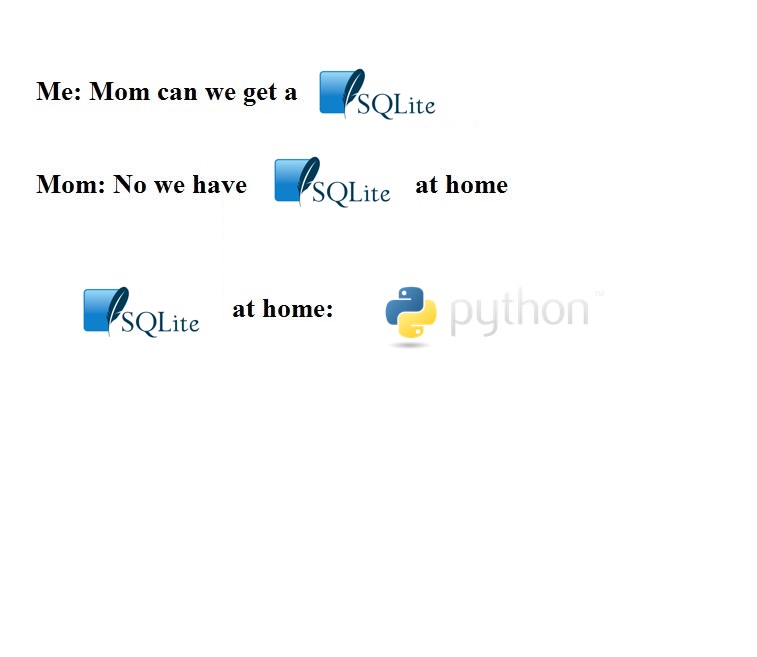

We spent a lot of time learning SQL, but tbh it’s a pretty limited language - it’s just a bunch of nested loops! So why don’ we just write loops instead? Yes.
In this homework, we’ll do it the hard way and implement “SQL at home”. Really we’ll try to implement the relational algebra operators. This will solidify our knowledge of relational algebra. As Feynman said, “what I cannot create, I cannot understand”.
Let’s start with representing table schema. Recall the schema of a table lists its column names, along with the type of each column. As we will be writing Python which is untyped (also pronounced “dynamically typed”), we’ll just think about the column names. We use dictionaries to represent schema as follows:
p = {
"name": "casa",
"age": 8,
"origin": "seattle",
"kind": "cat",
"person": "remy"
}
print(p)Now to get a table of pets, we just have a list of dictionaries:
pets = [
{
"name": "casa",
"age": 8,
"origin": "seattle",
"kind": "cat",
"person": "remy"
},
{
"name": "luna",
"age": 2,
"origin": "seattle",
"kind": "dog",
"person": "remy"
},
{
"name": "milo",
"age": 1,
"origin": "seattle",
"kind": "dog",
"person": "remy"
}
]You might notice a small difference between SQL tables and our hacky
version of tables using Python dictionaries: in SQL, each schema is
associated to an entire table, so every row in the table will have the
same schema. In Python, at least the way we’re doing it, each “schema”
is only attached to one row. So in theory we could also have added a row
with a “person” schema to the pets list. We can prevent
this by using a typed language, but let’s ignore this for now.
With some data in hand, we can start implementing the relational algebra operators. Let’s start with projection.
That was a special case of the general projection operator. But before we move to the general case, let’s consider the selection operator.
In the function above we hardcoded the condition
kind = "dog". In general, the selection operator should
take the condition as a parameter. To do that, we need to implement
selection as a higher-order
function.
Dict -> bool. This function should
return the list of pets that satisfy the condition defined by the
function.Now we can implement the general projection operator.
f of type Dict -> T for any T.
This function should return a list of the values of f
applied to each pet.The next interesting operator is the cartesian product.
| operator to merge
dictionaries, e.g. dict1 | dict2.Once we have the cartesian product, we can have joins.
But that’s quite an inefficient way to do joins! If we need to join
k tables each with n rows, we will have to do
O(n^k) work to compute the cartesian product. In practice,
joins are implemented using special algorithms. We will consider a
simplified version of the hash join algorithm. But before that, let’s
implement a “grouping” operator that will be useful for both the hash
join and “group by”.
kind to a list of pets of that kind.The “group by” is in scare quotes, because the output of the function above is not a relation. It’s rather the “first half” of the group by-aggregate operator, before we apply the aggregate function.
The function should return a dictionary mapping each value in the group by columns to the result of applying the aggregate function to aggregate column.
We’ll also use the grouping operator to implement the hash join.
Let’s start with the simple case. Suppose we have two tables,
R(x, y) and S(y, z), and we want to join them
on the column y. Let’s also assume S satisfies
the functional dependency y -> z.
y in
S to the corresponding value of z.R and S on
y by iterating over R and looking up the value
of z in the dictionary.That’s really the spirit of the hash join algorithm: instead of
having two nested loops over R and S, we build
a hash table for S and then do a single loop over
R to find the matching values. In general, when there may
not be a functional dependency, we need to be careful and keep all
possible values of z for each y.
y in
S to a list of values of z, such that
(y, z) is in S.R and S on
y by iterating over R and looking up the list
of values of z in the dictionary.With this, we’re now ready to implement hash join in the general case.
With this, we have implemented the basic operators of relational algebra. I guess we didn’t really need SQL anyways?